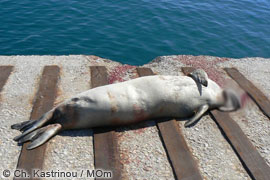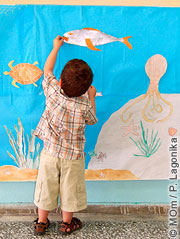

 |
||
 |
||
Vol. 11 (1): June 2008 |
||
Croatia / Greece I / Greece II / Madeira / Mauritania & Western Sahara / Turkey
Croatia
|
 |
|
|
|
The adult female weighed 200 kilos, was 2.20 metres long, and pregnant. The necropsy clearly showed the seal had been shot to death. The bullet had penetrated the lower thoracic cavity into the ventral area, causing internal haemorrhage and eventually, death. The skull of the animal had been skilfully skinned and removed, leaving the facial skin hanging off from the body. There was also a trauma near the seal’s genital area. This was most likely caused by a sharp tool, with which the seal must have been dragged either onto a boat or onto the shore, in order to be skinned.
With 20 years’ experience in monk seal necropsies the research team had examined deliberately-killed seals before, but had never encountered such a macabre sight. Regrettably, the culprit was impossible to find, but the case made prominent headlines in Greece, even raising the issue of monk seal protection in the Greek Parliament.
According to necropsies conducted over the past 20 years in Greece, one of the main factors driving monk seal mortality is still deliberate killing, due mainly to competition with fisheries. It is in addressing this factor that MOm and its organisational partners have embarked on the four-year, EU-funded MOFI project, aimed at devising means to mitigate the monk seal and fisheries conflict in Greece.
MOFI project partners
WWF Hellas
The National Fisheries Research Institute of Greece
Department of Virology, Erasmus University of Rotterdam
Department of Zoology, University of Aberdeen
MOFI funding bodies
LIFE-NATURE
Piraeus Bank
Prefecture of Magnesia
International Fund for Animal Welfare
The project ends in 2009. For more information, please visit www.mofi.gr. – Calliope I. Lagonika, MOm.
Every year, MOm produces a population Status Report on Monachus monachus in Greece. Viewed over a 5-year period, the annual results can yield deeper insights into the species’ population and its status in Greek waters.
Topics presented in the Status Report include distribution, habitat, biology, population size and trends, as well as limiting factors and threats.
Mediterranean monk seal sightings in 2007 by age group
| Age group | Field research activities | RINT |
| Newborn pups | 17 | 28 |
| Subadults | 0 | 55 |
| Adults | 12 | 98 |
| Unclassified | 0 | 54 |
| TOTAL | 29 | 263 |
Newborn pups recorded in Greece during MOm’s 2007 field research activities
| Source of data | Location | Number of newborn pups |
| MOm research activities (monitoring, rescue, field research) |
Kimolos-Polyaigos Island | 7 |
| Argolida | 1 | |
| Gyaros Island | 7 | |
| Tinos Island | 1 | |
| Skopelos Island | 1 | |
| Rescue and Information Network | Milos Island | 2 |
| Karpathos Island | 1 | |
| Kavala | 2 | |
| Evoia Island | 2 | |
| Zakynthos Island | 1 | |
| Kythira Island | 1 | |
| Magnesia | 1 | |
| Naxos | 1 | |
| TOTAL | 28 |
– Calliope I Lagonika, MOm.
In order to exchange information on marine mammals and fisheries interactions, in a fast and cost-effective manner and amongst a number of experts in various countries, MOm has set up the MMF Network (Network for Marine Mammals and Fishery Interaction). Electronic communications amongst the MMF members is already taking place, while the first workshop of the group took place on 10 May 2008 at MOm headquarters in Athens.
The subjects presented were:
Topics discussed included:
The meeting was organized by MOm within the framework of the EU-funded MOFI project. – Calliope I. Lagonika, MOm.
 |
|
|
|
Picture a group of kids, playing “sea games”, turning plain paper into animals, solving crossword puzzles and creating short stories by listening to the sound of rare animals. Can you find a more fun way to raise awareness about the marine environment when your audience is children?
With MOm’s brand new environmental education “suitcases”, children travel around the wonderful world of the marine ecosystems of the Mediterranean Sea, dive in our planet’s oceans and become aware of the threats facing the marine environment today. They also learn ways by which they can protect these fragile ecosystems.
The educational suitcases contain a teacher’s guide, an activities guide, loads and loads of games about the marine environment (with sounds, images, proverbs, memory tests, etc.), a comic featuring sea animals, audio and photo CD, a DVD, a book about the monk seal, posters and leaflets.
Each of the 10 suitcases stay at a school for two weeks, after which they are returned to MOm, for more travelling. The ‘travelling light in the Mediterranean Sea’ project is for children 4-7 years of age and for 8-12 year-olds; it begins in September 2008.
The environmental education suitcases were produced in collaboration with the Bodossaki Foundation, a privately-owned public welfare organisation whose principal objectives are the promotion of education, human health and the protection of the natural environment of Greece. – Irini Tsevi, MOm.
The Fisheries Guide, one of MOm’s new environmental educational tools, is a short, concise and easy to follow guide to fisheries in Greece.
Flipping through its pages, you can read about the history of fisheries in different civilizations, the current state of the fishery sector, the problems it faces, and how those problems are interlinked with the state of the marine ecosystem.
The aim of the Guide is not only to inform, but also to raise awareness about the marine environment. Each thematic unit of the publication is followed by other sources of information as well as ways in which we, as individuals, can protect our seas. A list of press cuttings from Greek newspapers gives an overview of today’s issues facing the fisheries sector in Greece.
The Fisheries Guide was designed by MOm as a complementary tool to the environmental education programme of the MOFI project, but can also be useful to anyone who has a genuine interest in issues concerning the marine environment.
For a free copy of the Guide (available only in Greek), please contact MOm at or call us on +30 210 5222 888. – Irini Tsevi, MOm.
Six of the largest environmental NGOs of Greece recently joined forces against the Greek State’s readiness to allow trawlers to fish at distances less than that set by European regulation.
The six NGOs issued a strongly-worded request for the revocation of the Ministerial Decree of the Minister of Rural Development and Food, which permits fishing with trawling gear at a distance 1 n.m. from the coast, while the European Regulation 1967/2006 defining management measures for the sustainable exploitation of fishery resources in the Mediterranean Sea, explicitly limits fishing with trawlers to 1.5 nautical miles from the coast.
A specific exemption might be provided by Regulation 1967/2006, but only as long as it has “no significant impact on the marine environment” – something that is not substantiated by available scientific data. On the contrary, the data provided by the Hellenic Center for Marine Research demonstrate that trawling is the least selective of all fishing gear, with a bycatch and discards (i.e. marine organisms of no commercial value that are fished and thrown back to the sea) averaging 44% annually. In addition, trawling has detrimental effects on the marine environment, especially when gear is towed along the seabed, seriously damaging marine biotopes.
Through a joint press release, the six environmental NGOs expressed their disappointment in discovering that the Ministry of Rural Development and Food has proceeded with adjustments that are contrary to Regulation 1967/2006 without any previous consultation with stakeholders (fishermen, scientific community, environmental NGOs). Coastal fishermen associations also protested the decision.
The NGOs that put the Ministerial Decree under the spotlight, and requested its revocation are: Archelon/Sea Turtle Protection Society, Mediterranean SOS Network, Pelagos Cetacean Research Institute, Greenpeace, WWF Greece, and MOm/Hellenic Society for the Study and Protection of the monk seal. – Calliope I. Lagonika, MOm.
 |
|
|
|
Within the framework of the MOFI project (Monk seals and fisheries: mitigating the conflict in the Greek seas), MOm organized in March another two open public meetings at the key Aegean islands of Alonissos and Kalymnos. The first is at the heart of the National Marine Park of Alonissos, Northern Sporades, one of the most important habitats for Monachus monachus. The second hosts the largest fishing fleet of Greece, with more than 700 coastal fishing boats.
The aim of the open public meetings is to inform local people about the MOFI project, and to raise awareness amongst local stakeholders about the thorny issue of monk seals and fisheries. During the meetings, locals have the opportunity to express their views on the issue and talk with the project’s scientists about the conflict.
A short documentary, presented during MOFI’s open public meetings is available online.
Last but not least, MOm also held its fifth monk seal rescue seminar on Kalymnos. – Calliope I. Lagonika, MOm.
Mediterranean News continues with Greece II, Madeira, Mauritania & Western Sahara and Turkey...
Copyright © 2008 The Monachus Guardian. All Rights Reserved |